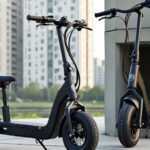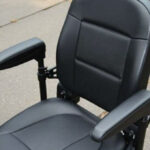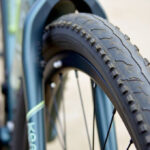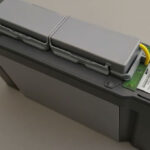The Importance of Proper Tire Inflation
When it comes to cycling, having the right bike tire pump can make or break your ride. Proper tire inflation is essential not only for a smooth and efficient journey but also for your safety. Under-inflated tires can lead to poor handling and increased risk of flats, while over-inflated tires can make for an uncomfortable ride and even cause blowouts.
To quickly address your needs:
- High-pressure pumps are best for road bikes with narrow tires needing high PSI.
- High-volume pumps are ideal for fat tire bikes requiring a lot of air at once.
- Compressor chamber pumps are necessary for seating tubeless tires.
The benefits of correct tire pressure are numerous. Your bike will handle better, you’ll experience less rolling resistance, and tire wear will be minimized. Not to mention, a well-inflated tire increases your overall ride efficiency, allowing you to go faster with less effort.
There are various types of bike tire pumps available, each suited to different needs. From floor pumps and mini pumps to CO2 inflators and electric pumps, understanding which one is right for you can make your cycling experience much more enjoyable.

Know your bike tire pump terms:
Types of Bike Tire Pumps
When it comes to keeping your bike tires inflated, there are several types of bike tire pumps to choose from. Each type has its own strengths and is suited for different situations. Here’s a quick rundown of the main types:
Floor Pumps
Floor pumps are the go-to for most cyclists. They are efficient and easy to use, making them perfect for home use. These pumps typically have a large barrel, which means you can inflate your tires quickly.
- Efficiency: The Schwinn Air Center Plus is a standout, requiring only 14 strokes to bring a road bike tire up to 100 PSI.
- Stability: These pumps often have a stable base, making them easy to use with one hand while holding the pump with your foot.
- Gauge Accuracy: Some floor pumps, like the SILCA SuperPista Digital Floor, come with highly accurate gauges, although not all are as precise.
Mini Pumps
Mini pumps are portable and can be carried on your bike or in a backpack. They are perfect for emergency tire inflation during a ride.
- Portability: Mini pumps like the Pro Bike Tool Mini Pump are small and lightweight, making them easy to carry.
- Versatility: These pumps can fit both Presta and Schrader valves, making them versatile for different bikes.
- Efficiency: While not as efficient as floor pumps, mini pumps are essential for on-the-go fixes.
CO2 Pumps
CO2 pumps use CO2 cartridges to quickly inflate a tire. They are compact and extremely fast, making them ideal for quick fixes during a ride.
- Speed: These pumps can inflate a tire in seconds, which is crucial during a race or a long ride.
- Ease of Use: Simply attach the pump to the valve and release the CO2. It’s that easy.
- Limitations: CO2 pumps are great for emergencies but not ideal for regular use due to the cost of cartridges.
Electric Pumps
Electric pumps are the latest in bike pump technology. They offer automatic inflation and are very user-friendly.
- Convenience: The CYPLUS Electric pump is an excellent example. It uses USB or USB-C charging and can automatically inflate your tire to a set pressure.
- Features: Many electric pumps come with additional features like built-in LED flashlights and digital pressure gauges.
- Portability: Although slightly larger than mini pumps, they are still portable and can be taken on rides.
Frame-Mounted Pumps
Frame-mounted pumps are designed to be attached to your bike frame, ensuring you always have a pump with you.
- Convenience: These pumps are always with you, eliminating the risk of forgetting them at home.
- Stability: They are securely attached to the bike, so they don’t rattle or fall off during a ride.
- Versatility: Like mini pumps, they are versatile and can fit different valve types.
Choosing the right bike tire pump depends on your specific needs. Whether you need a reliable floor pump for home use or a portable mini pump for emergencies, there’s a perfect option out there for you.
How to Choose the Right Bike Tire Pump
Choosing the right bike tire pump can make a world of difference in your cycling experience. Here’s what you need to consider:
Valve Compatibility
First and foremost, check your bike’s valve type. There are two main types:
- Presta valves are commonly found on road and some mountain bikes. They are narrower and have a screw-top.
- Schrader valves are similar to car tire valves and are more common on mountain bikes and hybrids.
Many modern pumps come with smart heads that automatically adjust to fit both valve types. This feature is particularly handy if you own multiple bikes with different valves.
High Volume vs High Pressure
The type of tire you have will determine whether you need a high-volume or high-pressure pump.
- High-pressure pumps are ideal for road bikes with narrow tires that require high PSI (upwards of 120 PSI). These pumps have smaller chambers, making it easier to achieve high pressure.
- High-volume pumps are better suited for mountain bikes or fat tire bikes. They pump more air per stroke, which is perfect for larger tires that don’t need as much pressure.
If you own different types of bikes, consider a pump that can switch between high-volume and high-pressure settings.
Tubeless Tire Considerations
Tubeless tires are becoming more popular for their ability to run at lower pressures and reduce punctures. However, seating a tubeless tire can be tricky.
- Seating the tire: This process requires a large blast of air to seal the tire to the rim. Standard pumps might not be up to the task.
- Compressor chamber pumps: Look for pumps designed with a compressor chamber, which can release a burst of air similar to an air compressor. This makes seating tubeless tires much easier.
Pressure Gauge Importance
A pressure gauge helps you achieve the perfect tire pressure, which is crucial for a smooth ride.
- Accuracy: Not all gauges are created equal. Some are more accurate than others. For instance, the SILCA SuperPista Digital Floor pump is known for its precise gauge.
- Ease of reading: A large, easy-to-read gauge can save you from squinting and second-guessing your tire pressure.

Summary
Choosing the right bike tire pump involves considering valve compatibility, whether you need high volume or high pressure, tubeless tire needs, and the importance of a good pressure gauge. With the right pump, you’ll enjoy smoother rides and longer-lasting tires.
Next, let’s dive into a step-by-step guide on how to use your bike tire pump effectively.
Step-by-Step Guide to Pumping a Bike Tire
Preparing the Pump
Before you start, ensure your pump is compatible with your bike’s valve type. Most modern pumps come with smart heads that adjust to both Presta and Schrader valves. If your pump doesn’t have a smart head, you might need an adapter.
- Check Compatibility: Confirm your pump works with your bike’s valve type (Presta or Schrader).
- Ensure Functionality: Make sure the pump is in good working condition. Check for any cracks or leaks in the hose and ensure the gauge (if present) is readable.
Attaching the Pump to the Valve
Attaching the pump correctly is crucial for efficient inflation and to avoid damaging the valve.
Presta Valves
- Open the Valve: Unscrew the small brass cap at the top of the valve.
- Attach the Pump: Push the pump head onto the valve and secure it by flipping the lever.
Schrader Valves
- Remove the Cap: Unscrew and remove the plastic cap on the valve.
- Attach the Pump: Push the pump head onto the valve and secure it by flipping the lever.
Inflating the Tire
Once the pump is securely attached, it’s time to inflate the tire.
- Start Pumping: Use smooth, steady strokes. For floor pumps, use both hands and apply even pressure.
- Monitor Pressure: Keep an eye on the gauge, if available. For example, the Schwinn Air Center Plus pump has a gauge that’s easy to read.
- Avoid Over-Inflation: Stop pumping when you reach the desired PSI. Over-inflating can damage the tire and reduce ride quality.
Checking the Pressure
Accurate tire pressure is key for a smooth ride and tire longevity.
- Use a Pressure Gauge: If your pump has a gauge, check it. For more accuracy, use a separate digital gauge.
- Ideal PSI: Different bikes require different pressures:
- Road bikes: Typically 80-130 PSI.
- Mountain bikes: Generally 30-50 PSI.
- Hybrid bikes: Around 50-70 PSI.
- Adjust Pressure: If the pressure is too high, release some air by pressing the valve. If too low, keep pumping.
By following these steps, you’ll ensure your tires are inflated correctly, making your ride smoother and more enjoyable.
Next, we’ll look at some of the top bike tire pumps of 2024 to help you pick the best one for your needs.
Top Bike Tire Pumps of 2024
Choosing the right bike tire pump can make a big difference in your biking experience. Here are some of the top pumps of 2024, each with unique features that cater to different needs.
Topeak Joe Blow Sport III
The Topeak Joe Blow Sport III is a reliable and well-rounded floor pump. It has a wide base for stability and a comfortable handle, making it easy to use. The thick metal base keeps it firmly anchored, even when pumping one-handed. The gauge is accurate, with an average difference of only 2 PSI, which is suitable for most bikers. However, it can be slightly tricky to get a good seal on Schrader valves.
Schwinn Air Center Plus
If speed is your priority, the Schwinn Air Center Plus is a top choice. It took only 14 strokes to bring a 700x25c road bike tire up to 100 PSI, making it 35% more efficient than its closest competitor. The “F-type” valve is easy to use and creates a solid seal. However, the gauge can be off by almost 9 PSI at high pressures, so it’s better suited for mountain bike tires or hybrid bikes rather than high-pressure road bike tires.
Bontrager Flash Charger
The Bontrager Flash Charger is known for its stability and accuracy. The digital gauge on the TLR Flash Charger is the most accurate, with an average difference of only 0.6 PSI. The analog gauge is also very precise. The sturdy metal base and smooth operation make it a reliable choice for all types of bikes. The only downside is that the connection can be a bit finicky.
CYPLUS Electric
For those who prefer minimal effort, the CYPLUS Electric pump is a game-changer. This mini compressor charges via USB or USB-C and has a built-in LED flashlight. Simply set the desired pressure, attach it to the valve, and hit start. The pump inflates the tire to the set pressure and then shuts off automatically. It’s compact enough to fit in your hand and comes with a soft carrying case, making it perfect for on-the-go use.
Pro Bike Tool Mini Pump
The Pro Bike Tool Mini Pump is an excellent choice for those who need a portable option. This mini pump is small but powerful, capable of inflating tires quickly. It fits both Presta and Schrader valves and comes with a secure frame mount. While it doesn’t have a gauge, its compact size and efficiency make it a great option for emergency use during rides.
These top pumps offer a variety of features to suit different biking needs. Whether you need speed, stability, accuracy, or portability, there’s a pump on this list that will keep your tires in top shape and your rides smooth.
Next, we’ll answer some frequently asked questions about bike tire pumps to help you make the most informed choice.
Frequently Asked Questions about Bike Tire Pumps
Do all bike pumps fit all bikes?
No, not all bike pumps fit all bikes. The compatibility of a bike tire pump depends on the type of valve your bike tires have. The two most common valve types are Presta and Schrader.
- Presta valves are usually found on road bikes and some mountain bikes. They are thinner and require a smaller opening.
- Schrader valves are similar to car tire valves and are commonly found on mountain bikes and hybrid bikes.
Many modern pumps come with smart heads or universal heads that automatically adjust to fit both valve types. However, some pumps may require an adapter to switch between valve types. Always check the pump’s specifications to ensure it matches your bike’s valve type.
Can I pump bike tires at a gas station?
Yes, you can pump bike tires at a gas station, but there are some important considerations:
- Compressor air vs. foot pump air: Gas station compressors are designed for car tires and can deliver air much faster than a manual foot pump. This can be convenient, but it also means you need to be very careful not to overinflate your bike tires.
- Caution with pressure: Bike tires, especially those with Presta valves, can be damaged by the high pressure from a gas station compressor. It’s best to use short bursts of air and check the pressure frequently with a gauge. For precise inflation, a dedicated bike pump with a built-in pressure gauge is safer.
Do tire pumps work on bikes?
Yes, tire pumps work on bikes, but it’s crucial to ensure they are compatible with your bike’s valve type. Here’s a quick rundown:
- Schrader valves: Most standard pumps, including those at gas stations, are compatible with Schrader valves.
- Presta valves: These require a pump designed for Presta valves or a smart head that can adjust between valve types.
Smart heads are a great feature because they eliminate the need for separate adapters. They automatically fit both Presta and Schrader valves, making the pumping process easier and more efficient.
In summary, while any pump can technically work on a bike, using one designed specifically for bikes ensures you get the right pressure without damaging your tires.
Conclusion
In summary, having the right bike tire pump is essential for maintaining your bike’s performance and safety. Properly inflated tires make your ride smoother, reduce the risk of flats, and extend the life of your tires.
Key Points
-
Types of Pumps: We explored various types of bike tire pumps, including floor pumps, mini pumps, CO2 pumps, electric pumps, and frame-mounted pumps. Each has its own advantages depending on your needs.
-
Choosing the Right Pump: Key factors to consider include valve compatibility, whether you need high volume or high pressure, considerations for tubeless tires, and the importance of a pressure gauge.
-
Pumping a Bike Tire: We provided a step-by-step guide on preparing the pump, attaching it to the valve, inflating the tire, and checking the pressure. Proper technique ensures you get the right pressure without over-inflating.
-
Top Pumps of 2024: We reviewed some of the best pumps on the market, such as the Topeak Joe Blow Sport III and the Schwinn Air Center Plus, highlighting their efficiency and ease of use.
Importance of Regular Tire Maintenance
Regular tire maintenance is crucial for a safe and enjoyable ride. Checking your tire pressure before each ride can prevent issues like flats and poor handling. It also ensures that your bike performs at its best, making your rides more efficient and enjoyable.
Doot Scoot as a Resource
For more in-depth reviews, guides, and tips on bike maintenance, check out Doot Scoot. We specialize in providing comprehensive eBike reviews and guides, helping both new and experienced riders make informed decisions. Whether you’re looking for the best bike tire pump or need advice on eBikes, Doot Scoot is your go-to resource for sustainable urban transport solutions.
By following these guidelines and using the right tools, you’ll keep your bike in top shape and enjoy a smoother, safer ride every time. Happy cycling!











